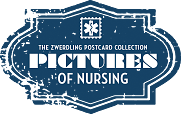Education Higher Education
Picture Perfect Images and Realities of Military Nursing During the World Wars
About the Module
Author
Loren Miller is a doctoral candidate in history at American University and a recipient of the Patrick Clendenen Fellowship in Women’s and Gender History. She is currently writing her dissertation entitled “Glamorous GI Girls: Constructing Servicewomen’s Identities During World War II,” which explores how and why the US government used the concept of glamour to recruit servicewomen, in addition to how servicewomen interpreted the concept during and after the war. Her research interests include women’s and gender history, visual and material culture, cultural history, and public history. Loren Miller has worked in public history since 2006, developing and researching exhibitions, archiving primary sources, and editing and writing educational resources. Some of the exhibition projects include “Silver Screen: How Films Shape Public Perceptions of Financial Regulation in the Twentieth and Twenty-First Centuries” at the Securities Exchange Commission Historical Society; “Housing Justice: 100 Years of Growth in a National Courthouse” at the United States Court of Appeals for the Armed Forces; “House of Cars: Innovation and the Parking Garage” at the National Building Museum; and “Arlington: From Private Home to National Memorial” at Arlington National Cemetery and Arlington House, The Robert E. Lee Memorial. Miller has also served as a teaching assistant for undergraduate classes on American history and culture, such as “Historians and the Living Past;” “Food, Media, and Culture;” “Work and Community;” “American Encounters: 1492–1865;” and “U.S. Foreign Relations Since 1914.”
Suggested Use
Picture Perfect Images and Realities of Military Nursing During the World Wars is an interdisciplinary module that uses visual and material culture approaches to understand the United States’ changing feminine ideals and American nurses’ involvement in World War I and World War II. The module’s broad focus on cultural history makes it appropriate for use in a variety of disciplines in the social sciences and humanities, including: history, cultural studies, visual and material culture studies, media studies, American studies, literature, and women’s studies.
The readings in this module have been chosen to highlight specific themes; they were designed to draw out the relationships between gender archetypes, the production and reception of recruitment and propaganda materials, and women’s lived experiences. The secondary source readings use a variety of scholarly interpretations to explore and contextualize American feminine ideals, survey how the models influenced the concept of nursing during the wars, and juxtapose the ideals with the realities of nurses’ experiences. The primary sources support the secondary readings by demonstrating government recruitment and propaganda materials, as well as allowing women to express their own experiences through their writings, photos, and oral histories.
Picture Perfect Images and Realities of Military Nursing During the World Wars builds on the exhibition “Pictures of Nursing: The Zwerdling Postcard Collection,” and students should familiarize themselves with the exhibition prior to using the module. The module expands upon the exhibition’s exploration of idealized images of nurses, in an effort to drive students to consider how ideal images are constructed and if they prescribe or react to general cultural tendencies, such as the romanticized concepts of professional femininity they tend to represent. Each class contains an overview, a list of readings, a list of Additional Online Resources, and discussion questions. While the questions are designed to draw out key elements of the readings, they should be used as a starting point for organic class discussions, stimulate students to think freely, and provoke them to deliberate the varied interpretations of history.
Objectives
At the conclusion of the module, Picture Perfect Images and Realities of Military Nursing During the World Wars, students should be able to:
- Recognize how cultural ideals are developed and propagated, and how they both reflect and dictate historical realities.
- Apply the visual and material cultural concepts of producers, institutional contexts of production, consumers, and reception to recruitment materials and propaganda, as well as analyze primary source images and how they are influenced by these factors.
- Identify propaganda, think critically about the term, and provide a nuanced definition for the word that considers its complexities and its complicated relationship to recruitment material.
- Realize that popular images and propaganda often depict idealistic qualities and experiences that do not represent large portions of the population or the realities of people’s lives during war.
- Compare female ideals and military nurses’ lived experiences in each World War, and compare the differences between ideals and experiences between the two time periods.
- Understand the historical realities and challenges of military nursing in the United States and the unique position military nurses held in comparison to female soldiers or civilian nurses.
- Demonstrate the ability to read, evaluate, interpret, and compare secondary sources and a variety of historical documents, specifically visual culture sources, to understand how historians interpret the past.
- Appreciate that all history is an interpretation of the past, which should always be critically analyzed.
Additional Resources:
The following websites contain excellent primary sources on women in the military, which can easily be added to the module or used in supplementary projects. They include posters, photographs, diaries, letters, and oral histories.


